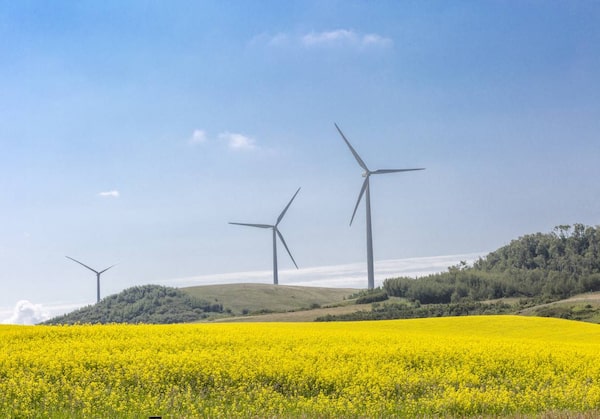
Today, the clean energy sector are more tangible than ever for both the public and investors.Getty Images/iStockphoto
Even just a few years ago, renewable energy projects were considered fairly costly. Many of them struggled to remain economically viable even though their sources of power generation – wind and solar – were essentially free.
Today, the sector still involves plenty of risk, but the rewards are more tangible than ever for both the public and investors. That's evidenced by projects such as Alberta's Renewable Electricity Program, announced earlier this year. The endeavour involves adding over $10-billion worth of green energy projects to its electricity-generation infrastructure by 2030, largely through generating stations primarily funded, designed and built by the private sector.
If successful, the program will boost green energy production to roughly 30 per cent of the province's total electricity needs in little more than a decade.
"It's an ambitious program for sure," says Andrew Cogan, managing director of Toronto-based Fengate Real Asset Investments, which specializes in private-equity, real-estate and infrastructure investments.
With the first round of winning bids expected to be made public later this year, developers and investors alike see the Alberta initiative as further proof the green energy industry is reaching a crucial tipping point economically.
"It's becoming an increasingly competitive space," Mr. Cogan notes. "And that's a good thing because it's shifted more toward a market-driven procurement process – like a reverse auction, if you will – where the lowest price of power wins."
The nature of clean energy projects is also changing, he adds. In the past, many were massive-in-scale, huge hydroelectric dams, like Churchill Falls Generating Station in Labrador, which was completed in 1974. Largely publicly-funded due to the cost and risk involved, these ventures took many years to bring online, Mr. Cogan explains. That's why today's provincial governments – which are responsible for the electricity system – seek to add energy capacity through smaller, more standardized projects, which involve less risk, cost and time to build.
"Now the typical privately-funded, utility scale project size ranges from about 10 to about 200 megawatts and can be completed within 18 months following start of construction, often faster. Many of these projects can be built at the same time across a province like Alberta, which stimulates local economies and accelerates progress towards green targets," Mr. Cogan says.
Provincial governments have already been moving in this direction for a few years, including New Brunswick, which generates more than 30 per cent of its electricity from renewable sources, according to 2016 data from the National Energy Board. New Brunswick is also accelerating its efforts with several small-scale projects in the pipeline, aiming to increase renewable energy's share of total electricity consumption to 40 per cent by 2020. Central to the success of these ventures in the Maritimes and elsewhere is the willingness of the private sector to participate in their development. Increasingly, investors and developers are keen to jump into the mix, particularly as metrics improve due to technological innovation.
"It's a sector we've been fiercely dedicated to for the last 10 years," Mr. Cogan points out. "We currently have 11 investments in the space."
Particularly attractive to investors are the steady yields these projects generate, which, according to Mr. Cogan, are generally stable and provide higher returns than many income-oriented, publicly traded securities.
"These power projects, when they're built, often have 20-year contracts with a fixed power price they will receive for generating electricity, so there's a lot of stability in terms of revenue," Mr. Cogan says.
Still, the sector is not risk-free. The move by the Ontario government in 2016 to halt its procurement process for clean-energy projects as costs exceeded estimates illustrates how the grass isn't necessarily greener if policy isn't crafted as well as it could be.
While the yield must be high enough to attract investors, it also must be sustainable. What's more important is that the asset must produce energy at a cost comparable to that of energy produced by non-renewable sources, and investors also take the risk that the sun will shine and the wind will blow.
Tim Nash, who heads up Good Investing, a green investment advisory company, argues, however, that investing in these projects typically involves less risk than, say, buying publicly traded companies that are developing and manufacturing green technologies.
"Investing in renewable energy projects is very similar to investing in real estate," says Mr. Nash, who also blogs about the industry at sustainableeconomist.com. "It's like owning and renting out a building, knowing your tenant will be there for the long haul."
By comparison, buying shares in a solar panel company is more of a growth strategy that could be negatively affected by government regulation and other risks. That said, growth investments stand to benefit when regulatory change is favourable.
"A carbon tax, for example, would spur growth in this industry that can't really be captured by existing green energy projects," Mr. Nash explains.
Despite their limitations, more and more capital is being allocated toward these yield-producing projects, as investors become more adept at assessing the risk and return of each individual venture.
"If you put a lot of research into your projects and have good local partners, the net result is you end up with a very steady and predictable cash flow," Mr. Cogan says. "And that's good news for investors."
This content was produced by The Globe and Mail's Globe Edge Content Studio, in consultation with an advertiser. The Globe's editorial department was not involved in its creation.